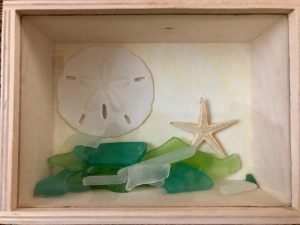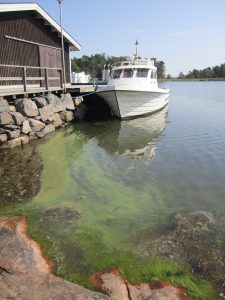Finland, Florida, Fiasco
During our summers on the beach, I remember the excitement of waking up early after thunderstorms that boasted spectacular lightning shows over the water. While my parents took advantage of the brief reprieve from the Floridian summer heat, my 6-year-old self embarked on a treasure hunt. I braved the awful stench of dead, rotting fish—likely casualties of the severe lightning—and searched through the rubble for perfectly intact remains of sand dollars, starfish, shells, and the occasional shark tooth. Much to my delight, I left that summer with numerous treasures, which allowed my mother and I to create arrangements for them in a glass vase and shadow boxes that all reside in my home to this day.
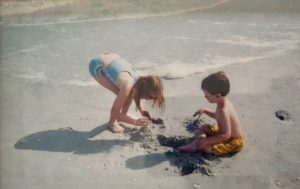
Though these decorations serve as nostalgic mementos, the memories remain emblazoned with the sight and smell of decaying fish carcasses piled on the shore.
I can only imagine that a similarly alarming situation—on an even greater scale—greeted locals and tourists alike during the Karena brevis red tide event in Florida this summer. In the midst of the red-tide-induced state of emergency declared by Governor Rick Scott, reports showed that the suspected K. brevis death toll included thousands of fish, manatees, eels, dolphins, sea turtles, and even a whale shark.[1]
Many people know that red tide is generally bad, but not “bad” enough to cause an official state of emergency. A bloom of photosynthetic, toxic dinoflagellate Karena brevis, which typically appears as a murky red cloud on the ocean surface, produces harmful brevetoxins. These brevetoxins make up a specific set of chemical compounds that have the potential to cause neurotoxic shellfish poisoning, which not only leads to fatalities among aforementioned charismatic fauna, but also severe health consequences in humans.
Neurotoxic shellfish poisoning, as stated in the name, most often occurs after the ingestion of brevetoxin-infected shellfish, and is characterized by gastrointestinal problems, nausea, vomiting, dizziness, and respiratory distress in humans.[2] Additionally, brevetoxins can become airborne due to the ocean’s breaking waves. Winds then transport these toxic aerosols towards shore, and subsequent human exposure causes eye irritation and a host of respiratory problems upon inhalation.[3]
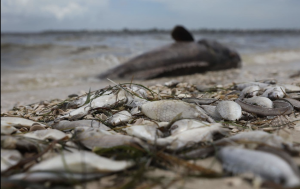
While experiencing the Finnish sauna for the first time, I considered the extent of the Florida red tide event in the context of the major cyanobacteria bloom in the Gulf of Finland. (And yes, Finns “take” sauna in full nude and consider it a relaxing bonding activity. For my first time taking sauna, my mentor and research supervisor Anke Kremp showed me the Finnish ways.) Attempting to adapt to the 90˚C heat (equivalent of 194˚F), the other women and I discussed the unusual summer conditions.
When I arrived in Finland (coincidentally the same weekend as Trump and Putin, but that’s another story), Finland happened to be the warmest place in all of Europe. Temperatures had reached a record high all over the country.[4] Any temperature over 25˚C (77˚F) Finns deem “hell,” which I ironically learned while sweating it out in the sauna.
Regardless, at the Tvärminne Zoological Station in southern Finland where I stayed for most of July and August, the cyanobacteria bloom exploded. Usually, cyanobacteria or “blue-green algae” exists in large conglomerates often near the shore. This bloom went above and beyond. Small flecks and large globs alike dotted the water as far as the eye could see, extending far past the shoreline.
I’ve been coming here for the past 20 years, and this is the first time I don’t want to swim, said a woman in the sauna in reference to the cyanobacteria. Many Finns go on holiday during July, visiting small red cottages along the Baltic Sea or various lakes throughout the country. It is traditional to take sauna, then jump into the lake or sea, sip cold beer, and repeat.
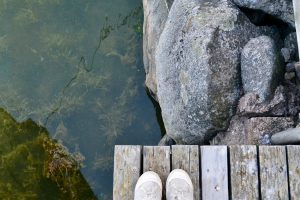
Kremp, who specializes in phytoplankton ecology and toxic algae, agreed and explained that cyanobacterial blooms are often driven by elevated temperatures and anthropogenic nutrient input. Because very few species of shellfish are harvested from the Gulf of Finland, these blooms rarely directly affect the fisheries. However, it does decrease tourism because it’s not only unsightly, but also poses health risks. Ingestion prompts gastrointestinal symptoms, including nausea, acute pain, diarrhea, and vomiting. Just swimming and not swallowing the algae-infected-water can lead to a rash, headache, and fever.[5]
While the dangers of cyanobacteria do not compare with that of Karena brevis, the factors affecting these blooms are eerily similar. First, both blooms have taken place in gulfs. National Geographic Society defines a gulf as “a portion of the ocean that penetrates land,”[6] but it’s helpful to think of it as an inverse peninsula of sorts. This means they very generally have similar oceanographic and hydrographic features, such as large horizontal and vertical stratification variations, high freshwater input, and less overall circulation in comparison with the open ocean.[7] Though these bodies of water differ significantly in scale—the Gulf of Mexico is about 50 times greater in terms of area—it still means that they are greatly affected by land and river runoff.
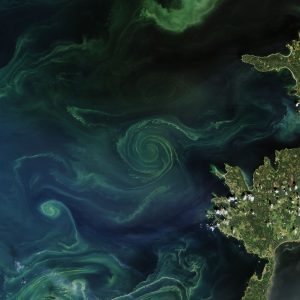
Second, both blooms likely result from high nutrient input, known as eutrophication, from anthropogenic sources. The amount of available nutrients (i.e. nitrogen and phosphorus) primarily regulates the maximal biomass any algal bloom can produce.[8] Over the past several decades, the population increase in south Florida has also increased the concentration of nutrients in the land and river runoff. Think: more (retired) people, more lawns, more golf courses, more fertilizer, more eutrophication. On the other hand, while anthropogenic nutrient loading plays a lesser role in the Gulf of Finland, still 70% of cultivated land in Finland is dedicated to agriculture.[9] This source of nutrient-rich runoff in conjunction with the surfacing of phosphorus-rich water from the depths of the gulf resulted in the largest bloom in the past decade this summer.
Third, both blooms represent aspects of a global environmental change. The “summer from hell,” as I’ve heard many Finns refer to it, was part of a larger heat wave that extended over the northern hemisphere. Reports have shown that it was the warmest July on record in Finland and Sweden; Spain and Portugal set new record temperatures (over 110˚F); temperatures in Helsinki surpassed 86˚F for the first time in eight years; several areas in the arctic erupted in wildfires due to the extreme heat.[10] Arguably, these increased temperatures are global warming at work. A consequence of this upward trend extends to the oceans, as studies have shown that sea surface temperatures have increased in the Gulfs of Mexico and Finland, as well as worldwide, due to climate change.[11] And increased sea-surface temperatures fuel harmful algal blooms.
Though these environmental changes seem minute—for example, the July heat record in Finland was broken by only 0.4˚C—the expansive toxic blooms of cyanobacteria and K. brevis show that even minor environmental changes can yield significant consequences. Overall, it’s important to remember that these negative effects impact real people. A similar K. brevis event would have prevented my family and I from spending quality time with one another on the Florida coast that summer and creating the fond memories I look back on today. During K. brevis events in southwest Florida, respiratory-related emergency room visits surge, costing 500,000 to 4 million USD.[12] Extreme heat augments mortality rates for the elderly by more than 20%. In Catalonia, the summer 2018 heat wave produced an estimated 23 deaths from heat stroke.[13]
So it seems, the consequences of climate change hit closer to home than we often realize. Not a bad reflection for my first Finnish sauna.
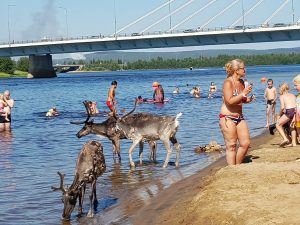
Sources
[1] https://www.vox.com/energy-and-environment/2018/8/30/17795892/red-tide-2018-florida-gulf-sarasota-sanibel-okeechobee; https://www.washingtonpost.com/news/speaking-of-science/wp/2018/08/14/red-tide-algaes-deadly-trail-of-marine-animals-has-triggered-a-state-of-emergency-in-florida/?noredirect=on&utm_term=.6befa47692e6
[2] https://journals.plos.org/plosone/article?id=10.1371/journal.pone.0058545
[3] https://www.sciencedirect.com/science/article/pii/S1568988305000910
[4] https://yle.fi/uutiset/osasto/news/july_heat_shatters_finnish_record/10332559
[5] http://www.syke.fi/en-US/Current/Algal_reviews/Bluegreen_algae_in_water_are_a_risk_for_(47443)
[6] https://www.nationalgeographic.org/encyclopedia/gulf/
[7] https://agupubs.onlinelibrary.wiley.com/doi/abs/10.1029/JC091iC12p14221; http://citeseerx.ist.psu.edu/viewdoc/summary?doi=10.1.1.476.168
[8] https://www.ncbi.nlm.nih.gov/pmc/articles/PMC5543702/
[9] http://www.syke.fi/en-US/Current/Nutrient_load_into_the_Baltic_Sea_contin(47430)
[10] https://www.aftonbladet.se/nyheter/a/qnBO9O/smhi-bekraftar-rekordvarm-juli-i-ar; https://www.bbc.com/news/world-europe-45070498; https://www.livescience.com/63107-arctic-sweden-wildfires.html
[11] https://www.sciencedirect.com/science/article/pii/S0141113605000073?via%3Dihub; https://agupubs.onlinelibrary.wiley.com/doi/10.1029/2002JD002670
[12] https://www.ncbi.nlm.nih.gov/pubmed/19672403
[13] https://www.diaridegirona.cat/catalunya/2018/08/16/salut-eleva-23-les-victimes/930417.html
